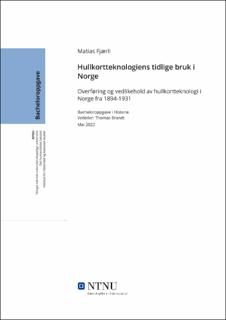| dc.contributor.advisor | Thomas Brandt | |
| dc.contributor.author | Matias Fjærli | |
| dc.date.accessioned | 2022-06-16T17:19:41Z | |
| dc.date.available | 2022-06-16T17:19:41Z | |
| dc.date.issued | 2022 | |
| dc.identifier | no.ntnu:inspera:110289010:35005064 | |
| dc.identifier.uri | https://hdl.handle.net/11250/2999113 | |
| dc.description.abstract | Tema for denne oppgaven er databehandling og datamaskiner fra perioden 1890 til 1930. Dette var en periode hvor databehandling ved hjelp av maskiner var i ferd med å bli etablert. Valget av et slikt tema begynte med en interesse for moderne datateknologi og digital infrastruktur, og fortsatte derfra mot historiske spørsmål om utviklingen mot en stadig mer digitalisert, data- og statistikkavhengig verden. Den tidligste fasen av datahistorien går mye lenger tilbake enn mange ofte tror. Flere av datahistoriens mest kjente selskaper, slik som International Business Machines (IBM) og den franske Bull gruppen, kan strekke sin historie helt tilbake til 1800-tallet og tidlig 1900, og begynnelsen av databehandlingsteknologiens historie. Allerede fra først halvdel av 1800-tallet kan det trekkes en rekke tråder som møtes på midten av det påfølgende århundret. Disse inkluderer kommunikasjonsteknologi (telefonen, radio og telegrafen), Kontor- og handelsmaskiner (skrivemaskinen, kasseapparatet), nye markedsstrategier (NCR, IBM), og et stadig voksende behov for statistikk i form av tabulerings utstyr til ulike formål. Det er disse teknologiene som etter hvert blir det man i dag kan kalle den moderne dataindustrien. Historien om Herman Hollerith og utviklingen av de første hullkortmaskinene på 1880-tallet, som etter hvert førte til etableringen av IBM på 1920-tallet, er velkjent i datahistorien. Mindre kjent er det norske kapittelet i hullkortteknologiens historie. Gjennom datahistorien har flere nordmenn vært sentrale for den videre utviklingen, Blant disse ble særlig to historier trukket fram som interessante for en oppgave. Disse var Anders N. Kiærs tidlige bruk av Hollerith-maskiner, selv i internasjonal sammenheng, som direktør i Statistisk Sentralbyrå, og Frederik Rosing Bulls norske hullkortmaskiner, som skulle bli en av svært få selskaper som konkurrerte mot IBM i denne bransjen. | |
| dc.description.abstract | The subject of this thesis is computing and computers from about 1890 to 1930. This was a period where computing with the help of machines was just becoming viable. The choice of such a topic began with an interest in modern computer technology and digital infrastructure which moved on to historical questions about the development of an increasingly digitalized, data- and statistics-dependent world. The earliest period of computer history goes back a lot further than people often believe. Several of the most famous companies in computer history, such as International Business Machines (IBM) and the French Bull group, can trace their history all the way back to the 19th century and early 1900s, and the beginning of the history of computing technology. From as early as the first half of the 19th century, several threads can be traced that converge during the following century. These include communication technologies (the telephone, radio and the telegraph), office and trading machines (the typewriter and cash register), new marketing strategies (NCR, IBM), and an ever-increasing need for statistics in the form of tabulation equipment for various purposes. These technologies would gradually evolve to become what we today call the modern computer industry. The story of Herman Hollerith and the development of the first punched card machines in the 1880s, which eventually led to the establishment of IBM in the 1920s, is well known among historians of technology. The Norwegian chapter in the history of hole card technology is however less known. Throughout the history of computing, several Norwegians have been central to the further development. Among these, two stories were highlighted as interesting for this thesis. These were Anders N. Kiær's early use of Hollerith machines, even when seen in an international context, as director of Statistics Norway, and Frederik Rosing Bull's Norwegian punched card machines, which would become one of very few companies competing against IBM in this industry. | |
| dc.language | nob | |
| dc.publisher | NTNU | |
| dc.title | Hullkortteknologiens tidlige bruk i Norge:
Overføring og vedlikehold av hullkortteknologi i Norge fra 1894-1931 | |
| dc.type | Bachelor thesis | |
